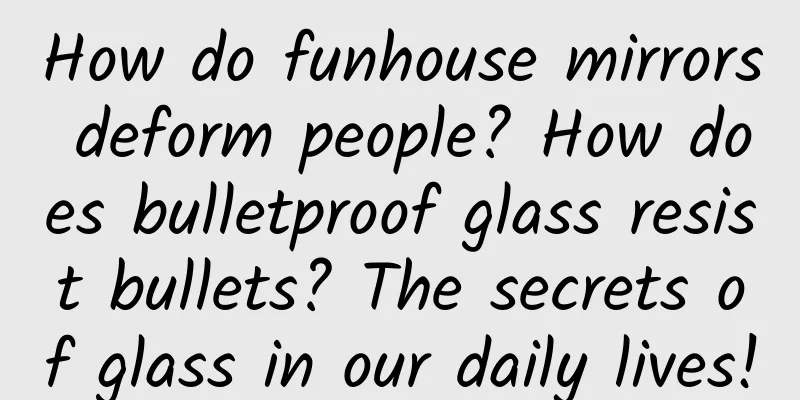How do funhouse mirrors deform people? How does bulletproof glass resist bullets? The secrets of glass in our daily lives!

|
Glass is very common in our lives. Whether it is a household mirror or a window, it is made of glass products. But, in addition to the ordinary glass at home, do you know more types of glass? For example, glass funhouse mirrors, glass two-way mirrors and bulletproof glass? Next, let us be curious and learn about the magical principles behind these glasses! 1 How do funhouse mirrors deform people? Funhouse mirrors are often found in amusement parks or large shopping malls and can distort objects in the mirror. It is not made up of a smooth plane like a common mirror, but is mostly a concave mirror or a convex mirror, or a combination of the two. Now I will explain to you from an optical perspective how funhouse mirrors can cause people to become deformed. The funhouse mirror in the children's playground of Beijing Science Center Source: Photographed by the author The concave mirror uses the principle of light reflection, and its special surface shape can make the light converge. When we put an object in front of the concave mirror, a light path like the following will be generated: Concave mirror imaging optical path source 丨 Internet We use arrow AB to represent an object. After a series of reflections, AB forms an enlarged virtual image A'B' behind the concave mirror. This explains why when we stand in front of a concave funhouse mirror, the virtual image of our body in the mirror will be distorted and enlarged, becoming fat and tall. Similarly, let's take a look at the light path of a convex mirror: Convex mirror imaging optical path source 丨 Internet It can be seen that after a series of reflections from the convex mirror, the virtual image formed behind the mirror becomes smaller, so the object in the convex mirror appears smaller than it actually is. As for the funhouse mirror that is a combination of concave and convex surfaces, we only need to combine the above two principles when analyzing. When standing in front of such a funhouse mirror, the body parts facing the concave side will be magnified in the mirror, and the body parts facing the convex side will be reduced in the mirror. As a result, we will be distorted in the funhouse mirror and become a "monster". Did you see the deformed test bench in the funhouse mirror? Source: Beijing Science Center Of course, the effect of the funhouse mirror is not limited to glass. As long as the surface is smooth, curved, and has the ability to reflect light, a similar effect can be achieved. In the Beijing Science Center Children's Park, there is a group of funhouse mirrors with various curvatures. Friends are welcome to experience it for themselves. 2 Double-sided glass In movies and TV shows about criminal investigation and spy war, we often see such scenes: a criminal is locked in a bright interrogation room, and many policemen are standing in the next room (darkroom). The policemen can see the criminal's behavior clearly through the transparent mirror, but the criminal in the interrogation room cannot see the policemen observing him. Scenes on both sides of the double-sided glass Source: Screenshots from TV series and movies This kind of glass with one-way transmission is called double-sided glass. In fact, it is not magical at all, even a piece of ordinary glass can achieve a similar effect. I believe everyone has had this experience: in the dark night, when we look out the window in a bright room, we will find that the originally transparent window glass becomes like a mirror, reflecting the appearance of the room, while the scene outside the window becomes blurry. All this is actually caused by the different light intensity indoors and outdoors and the performance of the glass. You should know that no glass is 100% transparent. When light hits the glass, part of it is reflected back, part of it is absorbed by the glass, and the rest passes through the glass. Source: Internet We assume that there are two rooms with different ambient brightness. The light intensity in the left room is 100, and the light intensity in the right room is 10. Since the ability of transparent thin glass to absorb light is negligible, it can be ignored for now. When the light from the left side enters the glass to the right, 10% of the light is reflected and 90% of the light is successfully transmitted. At this time, the intensity of the light transmitted to the right is 90, and the intensity of the light reflected back is 10. When the light from the right enters the glass to the left, 10% of the light is reflected and 90% of the light is transmitted. At this time, the intensity of the light transmitted to the left is 9, and the intensity of the light reflected back is 1. For the person in the bright room on the left, the intensity of the light reflected back from the glass is 10, while the intensity of the light transmitted through the right is only 9. The light transmitted through is not as strong as the light reflected back from the glass. For the human eye, it is easier to see clearly when the light is strong. Therefore, to the people in the house on the left, the glass can reflect the indoor scene like a mirror, and can also vaguely see the scene from the opposite room. Ordinary glass source: Internet However, the scene inside the room on the right is quite different. The brightness of the light coming through from the left is 90, while the light intensity inside the room on the right reflected from the glass is only 1. The light coming through is obviously stronger than the reflected light. Therefore, for people in the room on the right, this glass is almost transparent, and they can clearly see the scene inside the room on the left through it. Glass with a transmittance of 90% Source: Internet By utilizing the effect brought about by the brightness difference between the two rooms, even a piece of ordinary glass can achieve the effect of double-sided glass, and the greater the brightness difference between the two rooms, the more obvious this effect will be. In addition to increasing the brightness difference between the two rooms, people usually coat the glass surface with a thin layer of silver film in order to further improve the one-way perspective performance of the glass under different light intensities on both sides. Silver film can block light from passing through glass, increasing the reflectivity of the glass and reducing its transmittance. When the reflected light increases and the transmitted light decreases, the one-sided transmittance effect introduced above will become more obvious. When the reflectivity is 50%, that is, the intensity of reflected light and transmitted light is half of the incident light, the one-sided transmittance of the glass is best. People in a bright room cannot see what is happening behind the glass at all, but people in a dark room can clearly see every detail on the other side of the glass. Glass with 50% transmittance source丨Internet Interested friends can calculate and prove it by themselves~ 3 Bulletproof glass Bulletproof glass is also a "frequent visitor" in movies and TV dramas. When a gunman wants to shoot some important figures in a car, he will find that the bullets cannot pass through the car window glass, and the assassination will eventually fail. This is the effect of bulletproof glass. The jewelry store's security glass after the robbery, possibly hit by a bullet. Source: Wikipedia Bulletproof glass, also known as safety glass, is made by bonding three parts: load-bearing layer glass, transition layer material, and protective layer glass under high temperature and high pressure. The structure of bulletproof glass comes from the Internet The bearing layer is located on the outermost side of the bulletproof glass and is made of thick, high-strength glass. After being hit by a bullet, the bearing layer will break, absorb the kinetic energy of the bullet, change the shape of the bullet or destroy the bullet, making the bullet lose the power to continue to impact. The transition layer material has very good adhesion and a certain degree of flexibility. It is usually made of transparent plastic and can absorb part of the energy generated during the impact of the bullet, causing the direction of the bullet to change. Because the glass of the load-bearing layer is tightly bonded to the transition layer, when the glass is shattered by a bullet, most of the resulting fragments will remain attached to the surface of the transition layer, and there will not be a large amount of fragments flying around, thus ensuring the integrity of the structure. The innermost safety protection layer is also made of high-strength glass, which has excellent elasticity and toughness. It can absorb the remaining energy after being weakened by the load-bearing layer and the transition layer, further blocking bullets and ensuring that the bullets will not pass through the bulletproof glass. Test bulletproof glass source丨Internet As a layered composite material, bulletproof glass perfectly combines the "rigidity" of the glass on both sides with the "softness" of the middle transition layer, giving it excellent impact resistance. In the fields of construction, aerospace, machinery, etc., this "combination of rigidity and flexibility" idea is often used in material design, and composite materials have become an indispensable member of modern industrial materials. Of course, in addition to the three types introduced today, there are many novel special glasses used in various occasions in life, which bring convenience to our lives. You may as well look for them yourself. Audit expert: Miao Guangyao PhD in Condensed Matter Physics Source: Digital Beijing Science Center |
>>: Recycling and value empowerment: the "retirement" journey of power batteries
Recommend
Are electric cars afraid of cold? How Skywell developed its "self-heating" physique
This winter is particularly cold. Various places ...
Kuaishou advertising process and conversion rate improvement techniques!
Kuaishou - "Record the world, record you&quo...
Apple releases first public beta of OS X Yosemite 10.10.5
[[140925]] Apple recently released OS X 10.10.5 b...
How to do Valentine's Day marketing? Here are 6 tips for you!
Is Valentine’s Day Marketing Important? This time...
up to date! Data rankings of 59 advertising platforms!
Let’s take a detailed look at the data performanc...
China Space Day丨The stars and the sea, never stop!
April 24 The 7th China Space Day Turn back the clo...
A 32,000-year-old human skull fossil was discovered in Henan. What does this mean?
Expert of this article: Tang Huimin, PhD, Central...
How to become an excellent front-end engineer
[[145462]] Philip Walton, a front-end engineer fr...
Today is the beginning of the dog days. Why do the dog days sometimes last 30 days and sometimes 40 days?
"It is the dog days of summer, and the weath...
Apple releases quick security response update for iOS 16.2 Beta users
On November 17, one of the new features Apple int...
WeChat is trying to loosen the restrictions on external links! Actual test: WeChat can directly open the Douyin link page to watch
[[437428]] On November 29, today, WeChat official...
Even Tesla is not immune to charging problems
As the saying goes, "the army has not yet mo...
Respiratory diseases are coming in groups! Please remember the tips to avoid pitfalls when taking medicines
Autumn and winter are the peak seasons for respir...
How to carry out refined operations? See what Tencent's senior product manager said
When the product enters a relatively mature stage...
1029 Hi P Day creates the TV industry's Double Eleven PPTV focuses on opening the era of content + hardware customization
With the deepening development of the smart home ...




![Gentle White is Not White · Douyin 0-cost project: single-day income of 500, no work release, no account maintenance [video course]](/upload/images/67cc2821117aa.webp)




